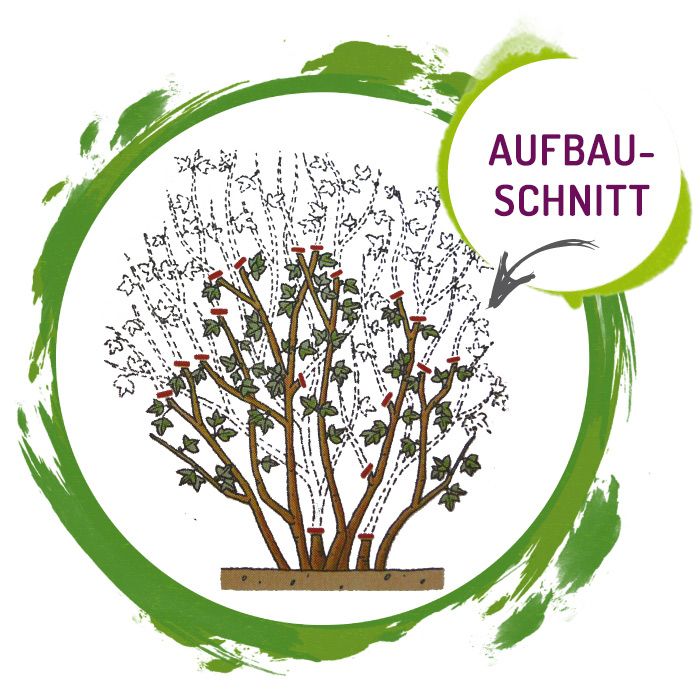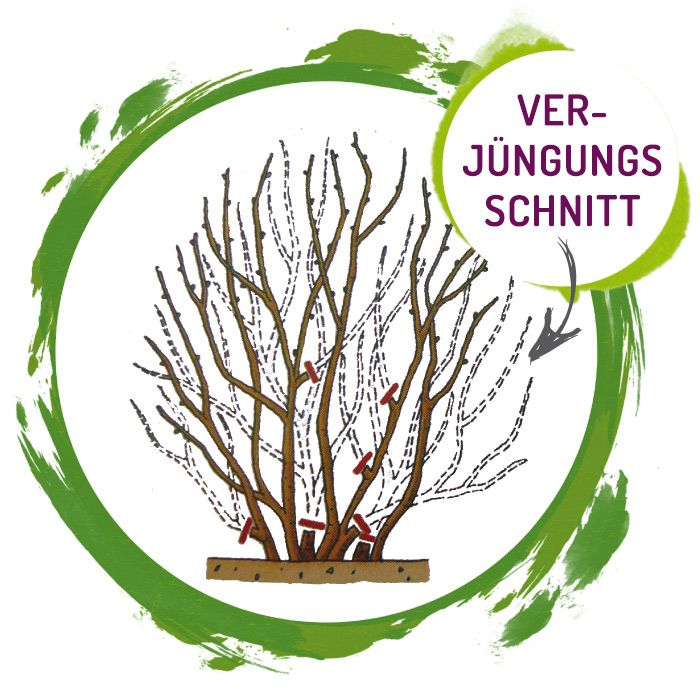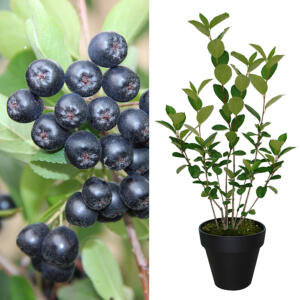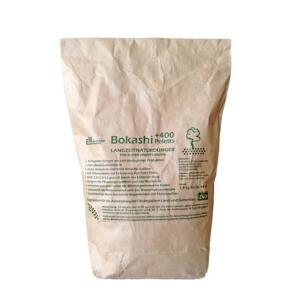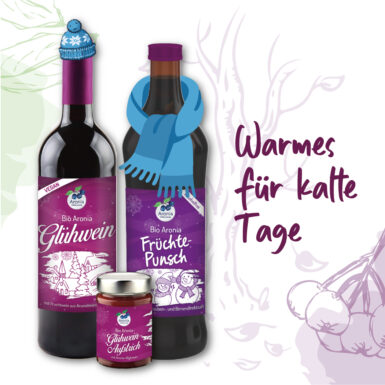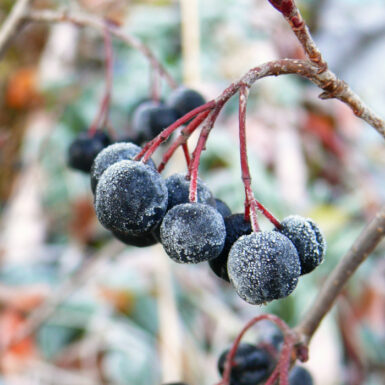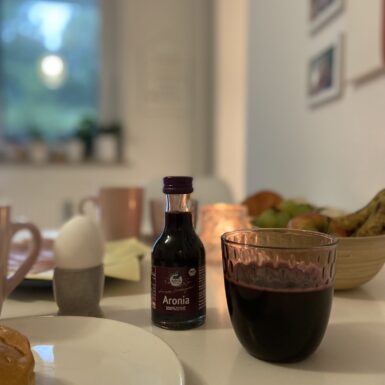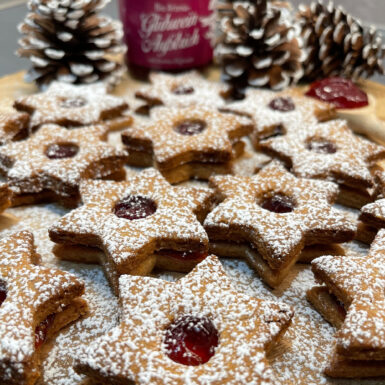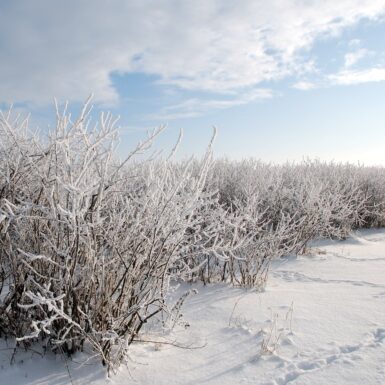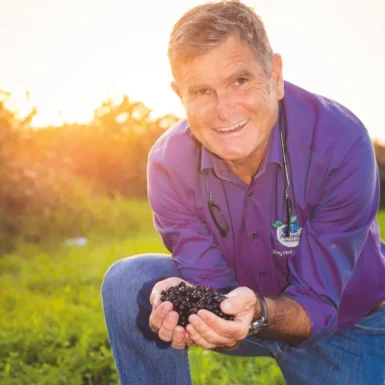
*
Tips from the aronia berry experts
*
Aronia plant advice
Have you decided to grow aronia plants in your garden? A good decision! With Aronia Nero, we can exclusively offer you a unique further development of the already well-known Aronia Nero. It is a newly cultivated variation of the most popular aronia berry variety, which has been bred over 30 years and is only available in our Aronia ORIGINAL Shop.
We are happy to help you with a few important tips so that you can enjoy your new aronia berry plant. You will find various pruning instructions (for potted plants and bare-root plants) as well as instructions for correct planting. We also provide you with practical cultivation tips for your aronia berry and wild plants.
Planting instructions for bare-root plants
Once you have received the bare-root Aronia Nero, please care for it immediately!
- Protect the bare root from sun, drought and frost.
- Until you plant the aronia berry, temporarily cover the bushes in soil or store the bare-rooted plant in a sheltered room and cover the roots with wet sacks.
Planting time: The planting period is from March to May and from September to November.
Pruning time: The aronia plant should be pruned in late fall, winter or early spring. However, the aronia berry very rarely needs blending.
- Loosen the soil and remove all weeds before planting.
- If necessary, you should work organic fertilizers such as horn meal, compost or manure into the soil.
- Before using the bare-root aronia berry, cut the fresh root tips, but only cut them off enough to remove any injuries. Shorten the shoots to 2/3 of their height. Please leave one central shoot longer as a leading shoot.
Dig a slightly deeper and larger planting hole that is bigger than the root volume. This prevents compaction in the soil and waterlogging can be avoided.
- Place the bare-root aronia berry in the center of the hole and cover with soil, including the root neck.
- The surface of the planting may be 2 to 3 cm higher than the soil outside the planting hole, as the planting surface will usually sink a little due to rain.
- Then water the plant generously.
Fertilization: Use organic fertilizers such as horn meal, compost or manure for fertilizing.
Stable manure contains important minerals and decomposes over 3 years. The straw in the manure stimulates soil life and produces humus. Liming improves the soil structure and raises the pH value. Bark mulch protects the soil from drying out and can prevent weeds.
- The Aronia Nero does not require any special care. It thrives on almost all soils. Only very calcareous soil hinders the growth of chokeberries.
- As the aronia berry is a very frugal plant, you hardly need to fertilize it.
- To rejuvenate the shrub, remove individual shoots.
- For pruning (1st and 2nd year of growth), remove crossing shoots and shoots that are too close together. Vigorous pruning leads to strong shoots.
Harvest: The aronia berry is a self-fertile plant and bears fruit from the 2nd year onwards. The ripe aronia berries can be harvested from the end of August/beginning of September, when the berries are black-red on the inside. Please note that the berries are very strongly colored due to their high anthocyanin content!
Planting instructions for potted plants
The Aronia Nero, which we have grown in pots, usually grows easily because it retains practically all its roots when transplanted due to its large root volume. It is not necessary to prune the plant before planting.
- Loosen the soil and remove all weeds before planting.
- If necessary, you should work organic fertilizers such as horn meal, compost or manure into the soil.
- Before you plant the Elbaronia, water it thoroughly and then take it out.
- Please plant the plants staggered and not higher or deeper than in the seed pot.
- Pour about 2-3 cm of soil over the pot ball
- Then press the soil down firmly without compacting it at depth.
- Then water the aronia berry vigorously. Avoid the midday sun. Please note that the peat substrate dries out more quickly than the natural garden soil!
Use organic fertilizers such as horn meal, compost or manure for fertilizing. Stable manure contains important minerals and decomposes over 3 years. The straw in the manure stimulates soil life and produces humus. Liming improves the soil structure and raises the pH value. Bark mulch protects the soil from drying out and can prevent weeds.
- The Aronia Nero does not require any special care. It thrives on almost all soils. Only very calcareous soil hinders the growth of chokeberries.
- As the aronia berry is a very frugal plant, you hardly need to fertilize it.
- To rejuvenate the shrub, remove individual shoots.
- For pruning (1st and 2nd year of growth), remove crossing shoots and shoots that are too close together. Vigorous pruning leads to strong shoots.
Harvest: The aronia berry is a self-fertile plant and bears fruit from the 2nd year onwards. The ripe aronia berries can be harvested from the end of August/beginning of September, when the berries are black-red on the inside. Please note that the berries are very strongly colored due to their high anthocyanin content!
Pruning chokeberries correctly (pruning instructions)
When cutting the aronia berry, use sharp tools and start just above a bud. If you want to start planting immediately, make sure that you shorten the shoots to about 40 cm and remove the crossing shoots. Leave a central shoot longer as a leading shoot (see diagrams below). Delivered aronia plants in pots do not need to be cut back at the time of planting!
Pruning measures for the cuttings we offer are only required in the first and second year of growth, later shoots are occasionally removed at the base for rejuvenation. For pruning, shoots that are too close together are removed and the basic shoot is shortened to encourage stronger branching. Strong pruning leads to strong shoots.
Here you will find detailed pruning and care instructions for our
bare root plants
and
potted plants
.
What are the benefits of Aronia Nero?
With Aronia Nero, we can offer you an exclusive and unique further development of the already well-known Aronia Nero. It is a newly cultivated variation of the popular aronia berry variety, which has been bred over 30 years and is only available in our Aronia ORIGINAL Shop. Aronia Nero has excellent plant-growing characteristics that set it apart from related woody plants.
Our Aronia Nero has unique characteristics:
- It is more resistant to heat and frost, as well as fungi and bacteria, i.e. it is almost resistant to diseases and pests
- It has even more aromatic fruit and is therefore ideal for direct consumption as fresh fruit or jam etc.
- It produces a higher yield with an above-average fruit size
- They grow more calmly and evenly, i.e. they require less pruning
Aronia Nero is a great novelty that will delight you with its many large fruits. The firm-fleshed berries are a deep black and grow in umbels on the bush. This makes them easy to harvest. Their extremely fruity and aromatic taste makes them a nice change from the summer berries on offer, especially for children.
With Aronia Nero you get what the name promises. Fresh fruit contains vitamins C, K and A as well as polyphenols.
Our Aronia Nero is grown along the picturesque Elbe Valley between Dresden and Meissen. Over the past 30 years, the largest Elbaronia plantation in Western Europe has developed there. The experience of the Saxon fruit growers in cultivation and breeding brings a truly top-quality product to your home garden – our Aronia Nero.
The plant’s robustness against cold and wind, its high yield and its natural resistance to fungi and bacteria make Aronia Nero our new favorite variety. Are you curious? Then order our aronia plants now!
Are you curious about our Nero? Would you like to enrich your garden with this wonderful aronia berry variety? Then simply go to the Aronia ORIGINAL Shop now and order our aronia plants!
Get started now
With the aronia plant, you can enjoy it all year round in the garden or as a potted plant on the balcony or terrace! White flower umbels appear in May, which bear dark purple berries in late summer before the plant turns bright red in autumn.
If you have any further questions, you may find it helpful to take a look at our FAQ - frequently asked questions. If you can't find what you're looking for there either, don't hesitate to contact our plant experts on the Aronia ORIGINAL hotline (Tel. 0351 896 659 0 Mon - Fri from 8.00 am to 4.30 pm). We will also be happy to help you personally.
We Here for Help You
We connect buyers and sellers of natural, organic, environmentally sound products. We find the best suppliers and makers of natural and organic products.
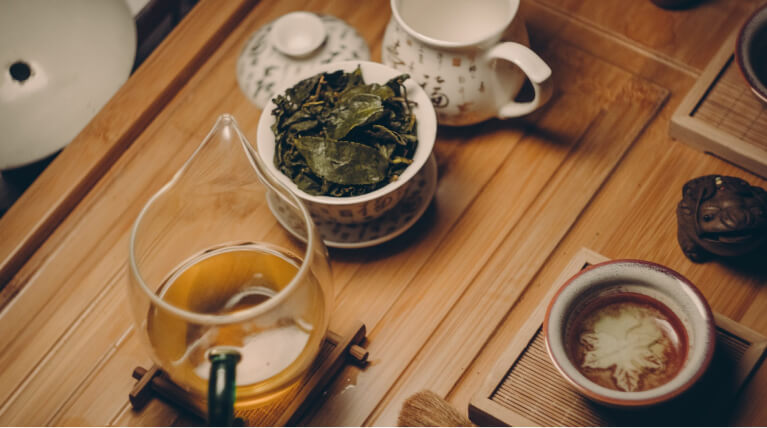
News & Updates
Lorem ipsum dolor sit amet, consectetur adipisicing elit, sed do eiusmod tempor incididunt ut labore et dolore magna aliqua.
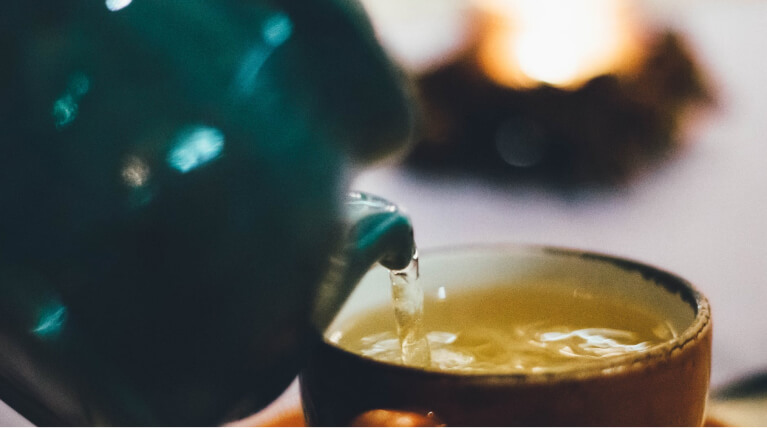
For Investor
Lorem ipsum dolor sit amet, consectetur adipisicing elit, sed do eiusmod tempor incididunt ut labore et dolore magna aliqua.
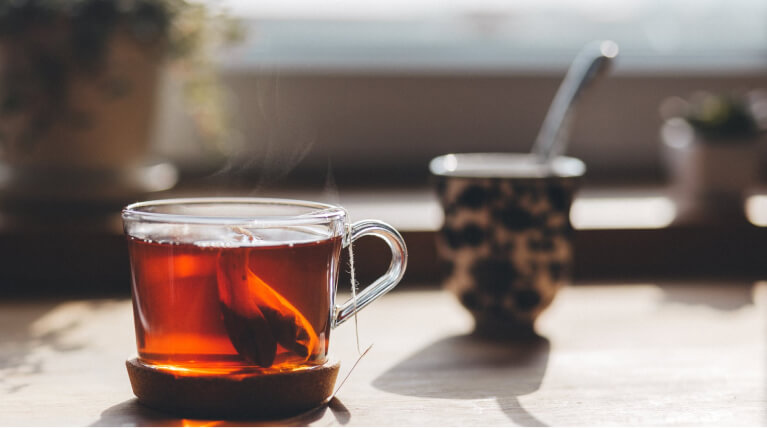
For Customers
Lorem ipsum dolor sit amet, consectetur adipisicing elit, sed do eiusmod tempor incididunt ut labore et dolore magna aliqua.
